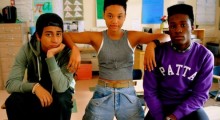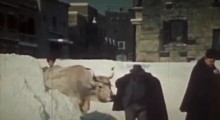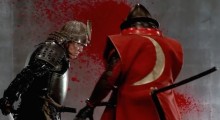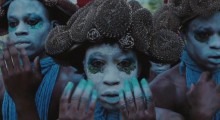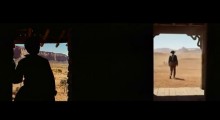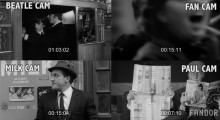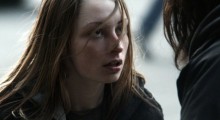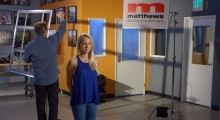Filmmaker Videos
-
Trailer Watch: Rick Famuyiwa’s Dope

Here is a bizarre entry in the contemporary trailer cannon: a one minute plus edit that gives almost no insight into the narrative happenings of the film it depicts, jettisoning specificity for internet topicality. The argument, I guess, is you can glean something about Rick Famuyiwa’s Dope from the execution on display, but I’m inclined to think that with all the memes involved, this is an eye-grabbing attempt more than anything else. The film, which earned raves at Sundance — with the notable exception of Wesley Morris — opens June 19 from Open Road.
-
Watch: 16mm Behind-the-Scenes Footage of Fellini Directing Amarcord

It’s not clear where this video uploaded by Eyes on Cinema derives from, and there’s no English subtitles, but here’s eight-plus minutes of rare footage of Federico Fellini directing 1974’s Amarcord. There’s fake snow to be packed together and set up, a typically Felliniesque array walking through it (a priest, a nun and a bull) and lots of Fellini slowly and decisively delivering directions on set.
-
Why Kurosawa Was a Master of Movement

Here’s another masterful film essay by Tony Zhou, this time on Akira Kurosawa’s use of movement in his films. Movement, you ask? Aren’t movies motion pictures and, thus, constructed around movement? Well, as a comparison scene from The Avengers shows, there is movement in the form of listless dolly moves and diffident head tilts, and then there is movement — elegant, multi-point master shots, vibrant background elements like wind and rain, and outsized expressions from actors that can replace pedantic dialogue. I especially like Zhou’s discussion of how Kurosawa cuts from stillness to movement. His appreciation here of Kurosawa has […]
-
Watch: “You and I and You” by Terence Nance

Though Terence Nance has been quiet on the feature front since An Oversimplification of Her Beauty, he’s been regularly churning out short films and music videos. Brandon Harris called his recent “magic-realist-tinged” Rotterdam entry Swimming in Your Skin Again “astoundingly beautiful” and “sublime,” and his latest music video, for Oversimplification collaborators The Dig, conveys a similar conflation of the concrete and surreal. It opens with a young family being trailed by a collective of dancers, and only takes off from there. Watch it above.
-
Watch: 55 Films’ First and Final Shots Side by Side

This video by Jacob T. Swinney is exactly what it sounds like: the first and last shots from 55 films paired side by side in splitscreen. There are obviously deliberate parallels (Rosamund Pike, before and after the discovery of Amazing Amy’s true nature in Gone Girl), color scheme parallels indicative of overall palette obsessiveness (Her), and shots which have no real connection but which trigger a lot of memories of the films involved. The music, regrettably, is from Thomas Newman’s American Beauty score.
-
Watch: Breaking Down A Hard Day’s Night Opening Sequence

Simple and effective: Kevin B. Lee breaks down the opening credits sequence of A Hard Day’s Night into four separate editorial strands. The main two are the “Beatles cam” trained on the running band and the “fan cam” following their screaming admirers; runners up are the “milk cam” (a guy eating in front of a milk ad) and the “Paul cam” (Paul in fake facial hair disguise, sitting out the pursuit). Each segment is timed with stopwatch precision, with all four parts arranged in a quadrant formation reminiscent of a security system, suggesting the surveillance that comes with celebrity. Very neat.
-
Trailer Watch: Josh and Benny Safdie’s Heaven Knows What

Timed to the SXSW debut of Josh and Benny Safdie’s Heaven Knows What is the film’s latest trailer from Radius. With stark, declarative titles attesting to the authenticity of the film’s storyline — Heaven Knows What is based on a memoir by the film’s star, Arielle Holmes, detailing her life on the streets while addicted to heroin — the trailer is a bold edit capturing the movie’s beguiling blend of underground romance and urban nightmare. Heaven Knows What opens later this Spring.
-
Exclusive SXSW Clip: Ben Powell’s Barge

World premiering in SXSW’s Visions section on Saturday is Ben Powell’s Barge, a project featured in IFP’s Spotlight on Documentaries Project Forum back in 2012. Aboard a towboat bound for New Orleans, Powell introduces us to the hands on deck, one of whom, Larry, is depicted in the exclusive clip below. Said Powell of his subject, “I wanted a well-rounded documentation of the crew and every position on the boat. On the last shoot I met a cook named Larry. He happened to be new to the kitchen after working as a deckhand for years. It seemed appropriate thematically to include […]
-
Watch: Shane Hurlbut on Sculpting Background Hard Light

We’ve spoken to d.p. Shane Hurlbut about camera tests and other matters before. In this video, you can see him in action: with a model in the foreground, he sets about messing with c-stands, toppers, and other tools to systematically create the illusion of a latticed window shadow behind her. Light is systematically managed and reduced for detail when Hurlbut decides he doesn’t want it to spill onto the floor, which is exactly what thoughtful light manipulation (with an equipment budget) is all about.
-
Watch: Eric Rohmer’s Uncertain Perspectives

I post my fair share of video essays, but arguably the most useful ones are the most specific, breaking down a filmmaker’s craft into a more ‘teachable’ method. Kevin B. Lee’s essay on the blocking, editing and camera perspectives at work in Eric Rohmer’s A Summer’s Tale is a prime example of the aforementioned. Lee clearly demonstrates how Rohmer crafts a world of uncertainty through reverse shots and eyelines, just as easily as he can lead the audience to side with a different character from one shot to the next via his cinematography.
